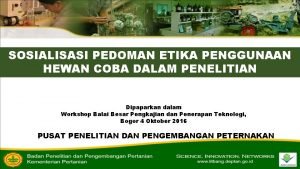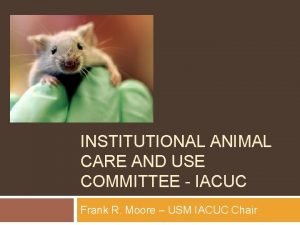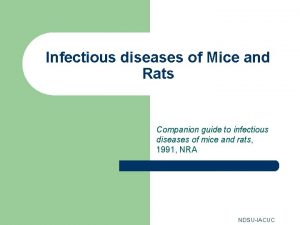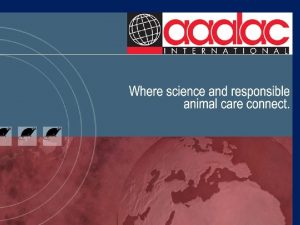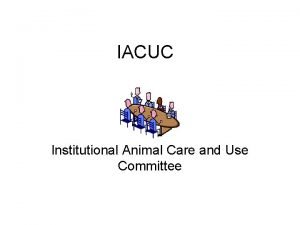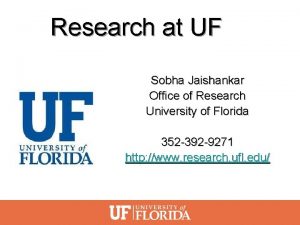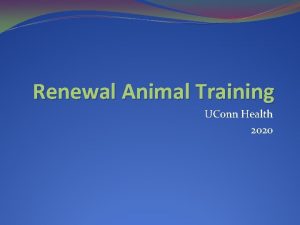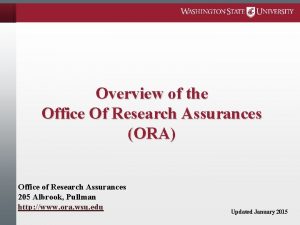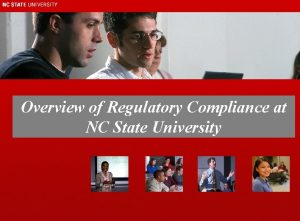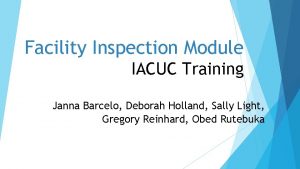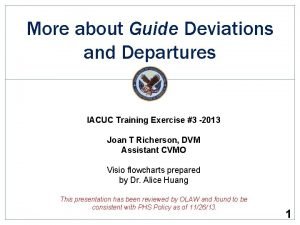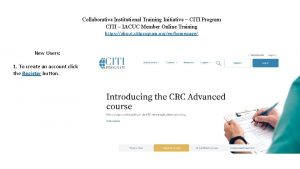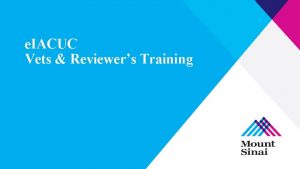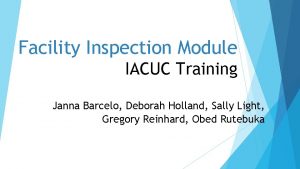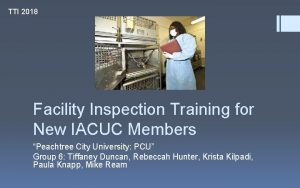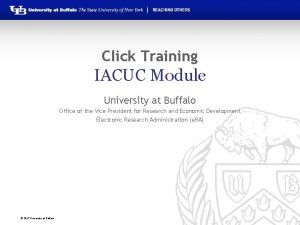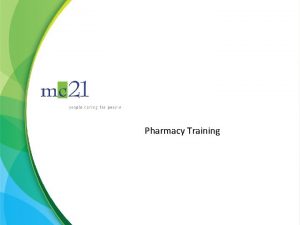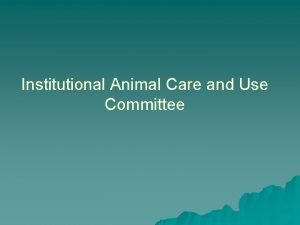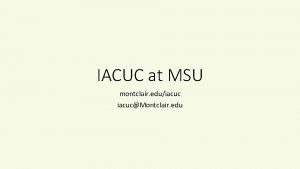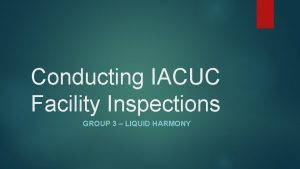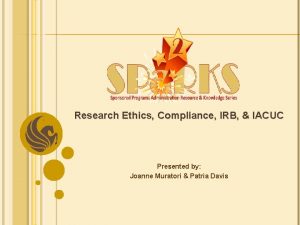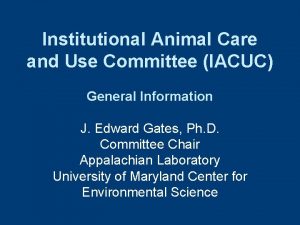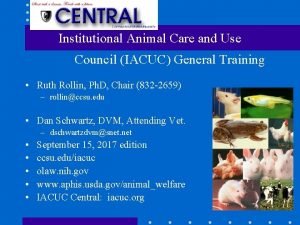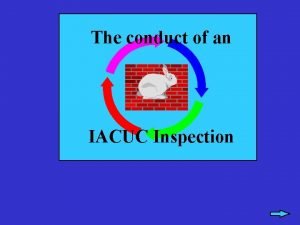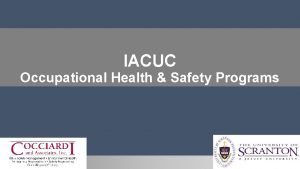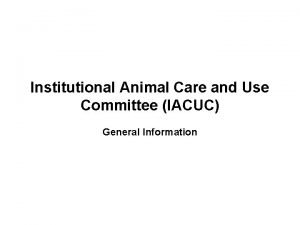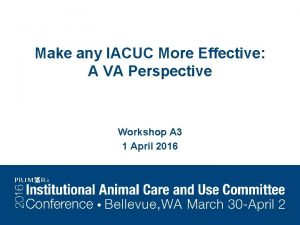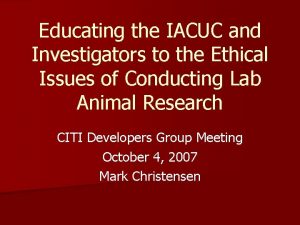IACUC TRAINING INTRODUCTION TO WORKING WITH THE IACUC










































- Slides: 42

IACUC TRAINING

INTRODUCTION TO WORKING WITH THE IACUC • Module designed to teach how you must conduct research and teaching using animals. • There will be an assessment associated with this material.

FEDERAL MANDATES • USDA: United States Department of Agriculture, which regulates animal research. • Animal Welfare Act. • The Department of Health and Human Services works in conjunction with the Office of Laboratory Animal Welfare (OLAW). • OLAW is responsible for monitoring institutional compliance with the Public Health Service.

REGULATING AGENCIES: USDA • United States Department of Agriculture(USDA): • Given broad authority to regulate animal research when Congress passed the nimal Welfare Act(AWA) in 1966. • The AWA remains the only Federal law regulating the use of animals in research and is considered the minimal acceptable standard. • The USDA then established the USDA Animal Welfare Act Regulations to enforce the AWA. • These regulations take precedence over regulatory documents produced by all other agencies. • The USDA has published a olicy Manual hat clarifies how some of the language in the USDA Animal Welfare Act Regulations should be interpreted.

THE ANIMAL WELFARE ACT • The AWA gives the USDA the authority to any institution that: • Uses live animals in teaching, research, tests, or experiments, and • Purchases or transports live animals in (interstate) commerce R eceives funds under a grant, award, loan, or contract from a department, agency, or instrumentality of the United States for the purpose of carrying out research, tests, or experiments. • The scope of the AWA is based upon the authority of the federal government to • regulate interstate commerce, and • its responsibility to make sure funds provided for animal research and testing are used appropriately. • Dealers who sell animals are covered by the AWA Regulations, as are xhibitors uch as traveling exhibits, carnivals, zoos, and shelters.

WHAT IS AN “ANIMAL”? • The USDA regulations define animals as: • "Animal means any live or dead dog, cat, nonhuman primate, guinea pig, hamster, rabbit, or any other warm blooded animal, which is being used, or is intended for use for research, teaching, testing, experimentation, or exhibition purposes, or as a pet. This term excludes: Birds, rats of the genus Rattus and mice of the genus Mus bred for use in research, and horses not used for research purposes and other farm animals, such as, but not limited to livestock or poultry used or intended for use for improving animal nutrition, breeding, management, or production efficiency, or for improving the quality of food or fiber. With respect to a dog, the term means all dogs, including those used for hunting, security, or breeding purposes. "

NIH AND PHS • PHS agencies include • the ational Institutes of Health (NIH) • the enters for Disease Control and Prevention CDC) • the ood and Drug Administration FDA). • While an institution which does not accept PHS funding are not technically subject to PHS Policy, many choose to follow it because it strongly promotes effective and ethical animal research programs

NIH AND PHS • Research animals are also subject to compliance oversight under the Public Health Service (PHS) Health Research Extension Act passed by Congress in 1985 and administered by the ffice of Laboratory Animal Welfare OLAW). • PHS Policy overs all vertebrate species sed for research, teaching, and testing in PHS-funded activities. • Compliance with PHS Policy is a required condition for receiving PHS support for activities involving vertebrate animals.

COMPLIANCE GUIDELINES AND DOCUMENTS • OLAW utilizes the following documents for compliance review: • 1. The HS Policy on Humane Care and Use of Laboratory Animals • Incorporates nine. S. Government Principles For The Utilization And Care Of Vertebrate Animals Used In Testing, Research, and Training • These regulation must be considered when institutions receive support from U. S. Government agencies • 2. The uide for the Care and Use of Laboratory Animals the uide) • 3. The uide for the Care and Use of Agricultural Animals in Agricultural Research and Teaching (the Ag Guide).

WHY AN IACUC? • IACUC = Institutional Animal Care and Use Committee • Law was passed that research institutions using animals must have such a committee in an effort to inspire confidence from the general public, • The AWA requires that all research facilities establish a committee “to assess animal care, treatment, and practices in experimental research as determined by the needs of the research facility and shall represent society’s concerns regarding the welfare of animal subjects used at such facility. ”

IACUC DUTIES • The AWA provides much of the basis for the composition and function of the Institutional Animal Care and Use Committee(IACUC). • The IACUC is required to review all aspects of the animal care and use program to • ensure that animal research and teaching activities are being performed in an ethical manner • according to the highest standards, and • in a way that avoids unnecessary pain and distress. • In accordance with AWA Regulations and PHS Policy the IACUC also monitors he animal care and use program by conducting program reviews and facility inspections at least semiannually.

IACUC TRAINING AND OVERSIGHT • The IACUC is also responsible for • Implementing training requirements • Investigating reports of harm to animals or noncompliance • Communicating with the USDA and OLAW. • Since the system is largely self-monitoring, even a single incident of serious noncompliance with animal welfare regulation or guidelines can jeopardize the entire institution's privilege of conducting animal research.

IACUC MEMBERSHIP • The IACUC is made up of a variety of individuals: • • • The Chairperson The Attending Veterinarian (AV) Scientists Nonscientists At least one member must not be affiliated with the institution. • When planning an experiment, you should get to know the following individuals: • • IACUC chairperson, secretary, or director: The IACUC chairperson is Dr. Laura Vogel, Biological Sciences The Research Ethics and Compliance Director is Kathy Spence. Institutional veterinarian: Dr. Colleen Gratton

IACUC MEMBERSHIP • At ISU, the IACUC and the Office of Research Ethics and Compliance (REC) work together to oversee the animal care and use program. • REC and the IACUC Chair can assist with information and guidance to help you obtain approval for your planned activities. • The AV can help plan experiments and provide medical and procedural guidance. • The AV is also responsible for • • • The animal healthcare program Overseeing the adequacy of animal husbandry and nutrition Sanitation practices, Zoonoses prevention and control Hazard containment. .

AN IACUC PROTOCOL • All research and teaching activities involving vertebrate animals must be conducted under an IACUC protocol submitted and overseen by a Principal Investigator (PI). • The protocol contains a complete description of all activities and procedures that have been approved by the IACUC for that specific project. • It also includes sections on • • • Husbandry Veterinary care, Justification of species and number of animals, Alternatives to animal use, Recognizing pain and distress, Euthanasia methods Restraint and handling. It is the PI’s responsibility to share the protocol with you so that you understand your responsibilities and the importance of complying with the protocol before you begin any protocol-specific activities covered by it.

REPORTING AND RECORDING MISCONDUCT • The IACUC is required under federal regulations to review and, if warranted, investigate any allegations of mistreatment or noncompliance, whether the report is made by an employee of the institution or by the public. • The IACUC has the authority to halt any animal activities and to impose and enforce appropriate sanctions. This may include termination of the protocol and revocation of the privilege of using animals. • The IACUC reports their action to the Institutional Official, who then has the authority to take additional action, such as review under research misconduct policies. • Both OLAW and the USDA must be notified if the suspended protocol involved PHS funding

REMEMBER: • The IACUC should protect the individual as well as the institution. • All animal research should be done in an ethical way. • Animals should not be subject to unnecessary pain and distress.

TRAINING REQUIREMENTS • PHS Policy, the SDA Animal Welfare Act Regulations, and the uides equire an institution to cover a number of specific opics s part of its training program for any individuals handling animals. • For research and teaching activities at ISU, PIs, staff and students who will be working in an unsupervised capacity must complete a more rigorous training program than students working in a completely supervised activity. • Specifics on training requirements are included in the “Vertebrate Animal Care and Use Training” SOP.

TRAINING REQUIREMENTS • Generally, individuals must be trained on the following prior to working with animals: • Humane methods of animal maintenance and experimentation, including basic needs of the particular species of animal, and proper handling and care. • Minimization of distress through the use of approved research and testing methods. • Proper use of analgesics, anesthetics, and other pharmaceuticals. • How to report deficiencies in animal care, including training on protections in place for personnel who report deficiencies. • Proper use of restraint equipment due to the risks to both animals and handlers. • Occupational Health and Safety.

FOR THE CANINE LAB: • The PHS Policy and USDA Animal Welfare Act Regulations and Standards state that personnel must be trained and qualified to conduct research. • All individuals working with the dogs should • Know the training procedures for working with the dogs • Know when and how to contact the veterinarians. • Know to whom reports of misconduct should be reported • Communicating and recordkeeping are essential. • The IACUC must be assured that individuals who will be working with animals are appropriately trained and experienced

INJURIES AND ACCIDENTS • If any injury occurs, immediately contact the unit supervisor. If needed, call 911. • All injuries must be reported to the unit supervisor, even if they do not seem serious. • Up-to-date vaccinations are strongly recommended • Injuries can be avoided in three easy steps • Prepare your work in an area in advance, • Make sure all equipment is functioning correctly. • Make sure all gates are shut, crates latched, dogs appropriately leashed. • Be able to recognize when an animal is becoming angry or defensive. • Handle animals with the minimum amount of agitation.

DOG BITES • Occasionally dogs bite. If you receive a bite from a dog in the laboratory: • Determine if the bite has broken the skin. If the bite has broken the skin: • • Immediately wash the wound under running water. If the wound is bleeding, apply pressure until the bleeding stops. Apply antibiotic cream to the wound and place a band aid over the wound. Seek medical treatment as soon as possible, if necessary. • . For a severe wound, a wound that will not stop bleeding, or multiple wounds: • Call 911 if the situation warrants an emergency. • Place a clean towel or cloth over the wound apply pressure until emergency help arrives. • Elevate the limb above the heart, if possible.

DOG BITES • The bite log form must be completed for any bite that breaks the skin. In addition, Dr. Farmer-Dougan or the lab TA must be immediately contacted. They are to sign the form, as well. • The Research, Ethics and Compliance office and the Chair of the IACUC must be notified if a bite does occur. If, for any reason, you cannot immediately contact Dr. Farmer-Dougan or the lab TA, please call 438 -2529 to report the incident.

DISEASE TRANSMISSION • Steps to follow to help prevent disease transmission: • Wash your hands with soap and water frequently. • Never eat or drink in areas where dogs are present. • Report all sick animals as soon as possible.

REPORTING MISTREATMENT • Any observed mistreatment of animals should be immediately reported to the AV, any member of the IACUC, or to REC. • Any animal that is in danger or in pain should be removed from the threat if that can be accomplished safely. • Emergency contact information is posted in every building at the ISU that houses animals. The information is also available on REC’s website. • Individuals are also encouraged to report any procedures that do not appear to comply with federal regulations or guidelines • Anyone reporting can do so anonymously. Individuals reporting are protected under the University’s whistleblower protection policies. If the individual is not satisfied with the response from the IACUC, they can contact OLAW or USDA to report their concerns. • .

ANIMAL CARE • Common signs an dog is injured or in distress • • • Not eating or drinking, e. g. , refusing to take high value treats. Refusing toys or interactive play. Panting when temperatures are moderate. Limping or holding up a paw Ears back, body positioned away from you, tail low. Sneezing, yawning, lip-licking • Every dog should be observed prior to, during and after a training or experimental session for signs of injury or distress. • If the dog shows significant signs of distress the session should be stopped immediately. • Any suspected problems should be reported immediately.

• Learn to identify body postures, vocalizations and behavior that indicate a dog is relaxed, alert or in distress. • Understanding canine communication signals is the best prevention for incidents between dogs and other dogs or dogs and people. • Report any adverse behavior, situations or conditions to your lab TA, Dr. Farmer-Dougan or the IACUC/REC immediately.

CANINE LABORATORY CONDITIONS • Each dog should have wear a collar with its name or I. D. number. • • We keep emergency contact information for each dog in a file. Dogs are client-owned an do not stay overnight in our lab. • Federal Law says that each animal must have enough space to allow for normal movements. • Our dogs may be crated in an appropriate size crate while awaiting their session in the laboratory. • Waste should be removed as often as necessary to keep animals clean and dry. • • Dogs should be taken for potty breaks at least every 2 hours. Any accidents must be immediately cleaned up and disinfected. • Extreme temperature requires a planned response for all animals. • • If temperatures are too extreme, we will close the laboratory until temperatures are moderated. Dogs may be taken outside to potty in cold or heat. However, their time outside should be limited to pottying. Walking and/or other outside activities will be cancelled.

OUTSIDE DOGS • All dogs MUST be on a leash ALL times when outside the building. No exceptions! • Dogs should wear the “in-training” vests or their service dog attire when outside • Always take a dog out in pairs. That way one person can handle the poop pick up, answer questions, etc. , while the other concentrates on the dog! • Remember, you and the dog are ambassadors for our program: Be a good example of positive trainers and well-behaved dogs. • You MUST take a poop bag with you if you leave the building…. and you MUST clean up after your dog. • Failure to clean up after your dog will result in lost lab points for that day!

POTTYING DOGS • Dogs are to be taken down the stairwell directly across from the lab, and out the door to the grassy area (maple tree in middle) outside the planetarium entrance for potty breaks. • The cue for service dogs is “busy” or “hurry up”. • Place any used poop bags in the outside trash. • Do not allow a dog to engage in play or exploratory sniffing unless it has pottied successfully…. otherwise you are reinforcing “play before potty” and you will be out there a very long time (or worse yet, the dog will come inside and eliminate on the floor!).

WALKING DOGS • Walking, while not directly training, is practicing training. You must remain in control of your dog. • Do NOT let the dog pull on the leash…. instead, practice loose leash walking: • Take treats with you so you can reinforce good behavior • If the dog pulls, stop, wait for the dog to return to the start position, C/T and begin again. • You may not get very far…. . that is okay…. . good manners are more important than distance! • C/T every few steps when walking to maintain good loose leash position. • If people approach the dog, move the dog a short distance away and prompt the people to ASK to greet the dog. • The dog should sit (and remain in a sit position) when greeted. C/T for good greeting behavior (the dog, not the approaching person!). • READ your dog’s emotional behavior. Do NOT let someone approach if your dog is looking nervous, upset or ambivalent about the approaching individual.

WALKING DOGS • Squirrels, birds, rabbits and other small animals are highly reinforcing…. . so you must be MORE reinforcing to your dog. • Prepare and redirect. If you see a small animal on your path prepare by directing the dog’s attention to you, moving your dog in the opposite direction, or stopping your dog and asking for sits and downs. • If your dog DOES attempt to chase, stand still, call your dog back and move your dog quickly in the opposite direction. • Use an excited voice to entice your dog to come with YOU • Use the “leave it” cue • C/T for appropriate behavior

AVOIDING ISSUES WHEN OUTSIDE • Anticipate approaching people and move your dog into a safe/secure position • Anticipate small animals and other distractions and redirect your dog before it can react. • Observe your dog’s behavior: if your dog is showing signs of stress or discomfort, come back inside immediately. • Your goal is to communicate to your dog that your dog is safe and can rely on you to communicate clearly and keep it from any harm. Be that person for your dog.

CANINE LABORATORY PROCEDURES: • Evacuating: 1. If the fire alarm or other evacuation order occurs, you must exit immediately. 2. If your personal items are easily reachable, grab your purse, wallet, backpack, etc. If not, leave them behind, Dr. Farmer-Dougan or the TA will lock the door. 3. Exit out the closest doorways: the main hallway door is directly across from the stairs. Follow the stairs down one floor. You may then proceed out the exit hallway towards the Planetarium/FSA 133 or through the fire doors into the hallway and out the doors emptying directly onto the School Street/College Avenue exit. 4. If, for some reason, the main hallway door is not accessible, exit through the side door. Follow the hallway out to the main hallway, turn right, continue down the main hallway, down the stairs, and out either set of outside doors. 5. If you are working with a dog, make sure the dog is on the leash and exit with the dog. Meet with the dog at the assigned meeting place.

CANINE LABORATORY PROCEDURES: • Dog Evacuation: 1. If you have a dog on a leash, exit with that dog. 2. If your assigned dog is in a crate and there is sufficient time, place a leash on the dog and exit with that dog. 3. Dogs should be walked immediately out the door and to the quad. Wait on the cement area near north-most garden bed between Schroeder Hall and Felmley Hall. Dr. Farmer-Dougan and her TAs will meet you there. We will then decide whether to wait for the all clear or to evacuate the dogs to a vehicle for transport.

CANINE LABORATORY PROCEDURES: • Tornado • If a tornado warning is sounded, again you must evacuate our laboratory. • If your personal items are easily reachable, grab your purse, wallet, backpack, etc. If not, leave them behind, Dr. Farmer-Dougan or the TA will lock the door. • Exit out the closest doorways: the main hallway door is directly across from the stairs. Follow the stairs down one floor and into the long hallway. • If you are assigned to move to safety with a dog, make sure the dog is leashed. Move out the door and down the stairs, but continue down into the basement with the dogs. This will ensure that they are sufficiently away from people should they become startled. • Dr. Farmer-Dougan will join you and find a safe location away from the crowd so we can sit with the dogs.

CANINE LABORATORY PROCEDURES: • Shelter in Place: • If a shelter in place emergency is called, you are to move to an interior room. Place your dog in the nearest crate. In case of an immediate emergency Dr. Farmer-Dougan and her TAs will tell you which dogs may be doubled up in the crates. • Go into Dr. Farmer-Dougan’s office or the TAs office and close the door. If there is an imminent threat, move the desk or furniture against the doors. • Dr. Farmer-Dougan’s door does lock. Get down on the floor, remain silent, and wait for further directions. • If you are not sure that 911 has been alerted in any situation, please feel free to contact emergency personnel using the office phone or your personal cell phone. Do not hesitate to call.

DOG FIGHT EMERGENCY PLAN: • Occasionally, dogs do interact with one another in an aggressive manner. • The best prevention for dog fights is careful observation to body postures, and interruption and removal from the area before a dog is allowed to become hyper-aroused. However, if a dog fight does occur the following procedures should be followed: • Do NOT attempt to pull the dogs apart by tugging on collars or sticking hands or other body parts near the dogs’ heads or mouths. This will usually result in the human being bitten.

DOG FIGHT EMERGENCY PLAN: • If two or more people are available to break up the dog fight: • Each person should grab the back legs of a dog, holding as near the hips as possible. Using a quick three-count (1 -2 -3), dogs should be pulled apart and swung in an arc away from one another using a firm grip on the rear legs. That is, swing the dog away from you and the other dog in an arc, and then pull the dog so it is outside of the grasp of the other dog. • Once the dogs can be pulled away from one another, grab the leash or collar and move each do to a separate location.

DOG FIGHT EMERGENCY PLAN: • If only 1 person is available to break up the dog fight: • Grab the closer dog back legs of a dog, holding as near the hips as possible. Using a quick three-count (1 -2 -3), pull the dog away from you and the other dog in an arc away using a firm grip on the rear legs. That is, swing the dog away from you and the other dog in an arc, and then pull the dog so it is outside of the grasp of the other dog. • Once the dog can be pulled away from one another, grab the leash or collar and move that dog to a separate location. • When the first dog is removed from the area, remove the second dog to a safe area

DOG FIGHT EMERGENCY PLAN: • Do not yell at or raise your voice to the dogs. Talk to the dogs in a calm manner. • Unless the dog is actively aggressive towards a human, remain with the dog and watch for calming signals (lip licking, head down, reduction of whale-eye, slower or absent panting, etc. ). • When the dog is calm, the dog may return to the work area on leash. Treat the dog for looking at you on cue, and have the dog engage in 10 or more default behaviors (sit, down, etc. ) for reward to get the dog back on track. • Once the dogs are calm and back in the training area, carefully observe the dogs for the remainder of the training session. Keep each dog’s focus on the trainer, and avoid close contact with one another.

FINAL COMMENTS • It is important to make sure you are following the Animal Welfare Act and the National Institutes of Health, Public Health Service Policy. • If you see any animal in danger or pain, immediately remove that animal and notify the care staff or veterinarian immediately. • Any injuries which may occur should be reported immediately. • If you see something that does not look right, report it. • If you are not satisfied with the actions of the IACUC, you may contact the Office of Laboratory Animal Welfare (OLAW) or the USDA Animal Care Section.
 Working hard vs working smart
Working hard vs working smart Hot hot
Hot hot Hot working and cold working difference
Hot working and cold working difference Differentiate between hot working and cold working
Differentiate between hot working and cold working Proses pengerjaan logam
Proses pengerjaan logam Etika penggunaan hewan coba dalam penelitian
Etika penggunaan hewan coba dalam penelitian Ub iacuc
Ub iacuc Rotavirus
Rotavirus Dlar pitt
Dlar pitt Cornell iacuc
Cornell iacuc My.iacuc.ufl
My.iacuc.ufl Uconn infoed
Uconn infoed Wsu iacuc
Wsu iacuc Ncsu pack portal
Ncsu pack portal Iacuc 3 rs
Iacuc 3 rs Gross operating cycle
Gross operating cycle Hình ảnh bộ gõ cơ thể búng tay
Hình ảnh bộ gõ cơ thể búng tay Bổ thể
Bổ thể Tỉ lệ cơ thể trẻ em
Tỉ lệ cơ thể trẻ em Chó sói
Chó sói Tư thế worms-breton
Tư thế worms-breton Chúa yêu trần thế
Chúa yêu trần thế Môn thể thao bắt đầu bằng chữ f
Môn thể thao bắt đầu bằng chữ f Thế nào là hệ số cao nhất
Thế nào là hệ số cao nhất Các châu lục và đại dương trên thế giới
Các châu lục và đại dương trên thế giới Công thức tính thế năng
Công thức tính thế năng Trời xanh đây là của chúng ta thể thơ
Trời xanh đây là của chúng ta thể thơ Mật thư tọa độ 5x5
Mật thư tọa độ 5x5 Làm thế nào để 102-1=99
Làm thế nào để 102-1=99 Phản ứng thế ankan
Phản ứng thế ankan Các châu lục và đại dương trên thế giới
Các châu lục và đại dương trên thế giới Thơ thất ngôn tứ tuyệt đường luật
Thơ thất ngôn tứ tuyệt đường luật Quá trình desamine hóa có thể tạo ra
Quá trình desamine hóa có thể tạo ra Một số thể thơ truyền thống
Một số thể thơ truyền thống Bàn tay mà dây bẩn
Bàn tay mà dây bẩn Vẽ hình chiếu vuông góc của vật thể sau
Vẽ hình chiếu vuông góc của vật thể sau Biện pháp chống mỏi cơ
Biện pháp chống mỏi cơ đặc điểm cơ thể của người tối cổ
đặc điểm cơ thể của người tối cổ Thế nào là giọng cùng tên? *
Thế nào là giọng cùng tên? * Vẽ hình chiếu đứng bằng cạnh của vật thể
Vẽ hình chiếu đứng bằng cạnh của vật thể Phối cảnh
Phối cảnh Thẻ vin
Thẻ vin





